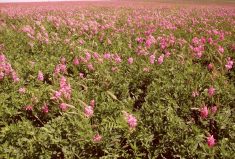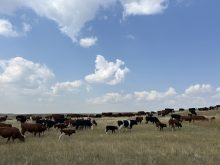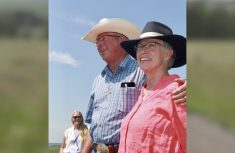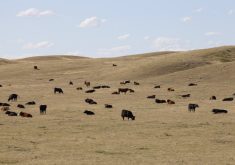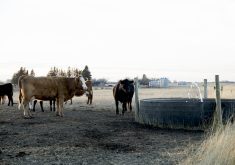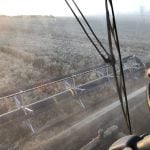In drought years it’s often challenging to provide adequate forage for cattle. Sometimes producers use alternative feeds which might include drought-stressed or salvaged crops.
Dr. Bart Lardner, professor in the department of animal and poultry science at the University of Saskatchewan, says some of the drought-stressed crops that might be available include annuals such as pulses, oilseeds or cereal crops that normally wouldn’t be used as livestock feed. If it’s not good enough to use as grain or oilseed production it might be harvested for cattle.
Read Also

Canadian Beef Check-Off Agency reports on investments and activities
The check-off agency’s work behind the scenes is what ensures cattle check-off dollars are invested wisely, accounted for transparently and deliver measurable value back to producers and importers.
“Crops like lentils, peas and canola can sometimes be put up as silage or greenfeed if they won’t make it for normal harvest. We get questions about canola, and it does make a fairly high-quality forage. It’s high in moisture, however, and a challenge to dry out because of hollow stems. You need to crimp it to get it to dry down,” he says.
Another thing to be aware of with canola hay or silage is that it tends to be high in sulphur — often 0.5 to one per cent. “You don’t want more than 0.4 per cent sulphur in the total diet or there can be issues with copper availability and ‘polio’ so you need to dilute it with other forages so canola is only about one-third of the total diet.”
Lentils and peas won’t have as many issues. Cool-season annual cereals such as barley and oats can be used, but be aware of possible nitrate problems if they are drought-stressed, says Lardner. It’s important to feed test to make sure it’s not above 0.5 per cent nitrate, he adds. If nitrate levels are not too high, oat or barley forage can be diluted with other feeds to bring nitrates in the total diet down to safe levels.
Some people also wonder about feeding flax to cattle. It can be done, but avoid immature flax, as it contains prussic acid (hydrogen cyanide). “Again, you’d need to dilute this down to one-third of the total diet,” says Lardner.
Alternative sources of forage might also include pulse straw. “This would be similar to flax straw. Pulse straw tends to have a little higher protein level than oil-seed straw-like flax or canola.”

A pulse straw can serve as a base forage because its fibre provides roughage in the diet. Producers can add an energy (carbohydrate) supplement, he adds.
“Pulse straw might not need a protein supplement because it’s about six to seven per cent protein, whereas typical cereal straw is about four to five per cent protein,” explains Lardner. The actual protein level in any forage will vary, however, depending on the drought and how dry the plant is.
Weeds in feed
Lardner also gets questions about kochia. There are two types of kochia. One is an annual invasive weed (Bassia scoparia) and the other a perennial forage plant (Kochia prostrata). Forage kochia is a non-invasive shrub and does not cause nitrate or oxalate toxicity.
“Annual kochia tends to be high in oxalates and can tie up calcium in the body.” Annual kochia has also been associated with nitrate poisoning, and photosensitization secondary to liver disease, but many cattle have eaten this weed when feed is scarce.
“Many weeds are nutritious, and cattle actually seek them out. Some broadleaf weeds like dandelion are fairly high quality,” says Lardner. Others, including pigweed and lamb’s quarters, are not as desirable, as they can contain oxalates. However, they may end up in hay bales, especially when putting up slough hay. Producers should be aware of possible high nitrate levels in these weeds as well, he adds. A few weeds consumed may not be a problem, but you wouldn’t want cattle eating forage with a high concentration of weeds.
“Another issue we’ve run into here is stinkweed, also called pennycress. In dry periods, cattle may eat hay containing high quantities of this weed and it can sometimes result in abortion or death. Stinkweed seeds contain high levels of glucosinolates, which can be toxic in high doses.” Glucosinolates are natural components of many pungent plants such as mustard, cabbage and horseradish.
Another toxic plant that cattle may eat when trying to find something green, especially along a ditch or creek bottom, is water hemlock, which is highly poisonous.

“We’ve already had issues with toxic plants here in some of our community pastures, including seaside arrowgrass, which is common in alkaline sloughs. This plant accumulates salt, which makes it attractive to cattle, especially if they don’t have salt/mineral supplement. It contains a nasty cyanogenic glucoside, but cattle eat it when looking for something green or salty,” says Lardner.
Cattle also eat a lot of tall larkspur (wild delphinium) if it’s the greenest thing in a dry pasture. Larkspur is nutritious, and cattle eat it readily. But it also contains several toxic alkaloids that can be a problem.
“Some milkvetches can be toxic,” says Lardner. Cicer milkvetch, the domestic variety often used as a non-bloating legume for cattle, is good feed, but the native cousins are not.
“The two-grooved or narrow-leafed varieties occur commonly in dry soils. These tend to be selenium accumulators, containing more selenium than needed, often at toxic levels.”
In a dry year, plant toxicity becomes a bigger issue, as normal forage plants are in short supply so cattle eat plants they would normally avoid. Hay fields are short, and many farmers this year are trying to bale ditch hay or anything that will make a bale.
“Some people ask about baling cattails and these can work. Most of our sloughs are dry and people can get into them with haying equipment.”
Another plant that often grows in sloughs is dock (Rumex). This reddish weed can contain oxalates but generally won’t cause problems. It may end up in hay when slough areas are baled.
Other plants that are considered weeds, such as wild oats, can also be eaten by cattle. Wild oats are nutritious and better than some of the other invasive weeds. During a recent tour of a pasture with grey-wooded soil, Lardner noted more invasive weeds such as absinth wormwood, a moderately poisonous species of Artemisia, which is related to sagebrush.
“Desirable forage species do poorly in dry conditions so invasive weeds take over. This year the absinth wormwood and tansy mustard are prolific,” says Lardner. If pastures are overgrazed, more invasive species will move in.
Withdrawal time for pesticides
Another issue when using residue from cash crops such as pulses or oilseeds as live- stock feed is the fungicides and herbicides used on those crops. Lardner says they get questions around withdrawal times such as how soon after application the crop can be grazed or harvested as cattle forage. But the chemical company generally won’t tell you whether or not it would be suitable for cattle feed.
“The chemical companies are suggesting a time frame of at least six weeks for canola, used for grain or meal, but won’t come right out and say that it’s safe to feed treated whole crops as hay to cattle,” says Lardner.
Other issues in a dry year may occur when cattle consume mature foxtail or cheatgrass and get sharp awns stuck in mouth tissues, causing abscesses and “lump jaw” that may require medical attention. Cattle don’t like these grasses when they are dry and sticky but eat them anyway when they end up in hay. This may cause more mouth abscesses than you’d see in a normal year.
“Foxtail — if eaten before it goes to seed — is good feed, and so is cheatgrass when it’s green, but dry seed heads often create problems.”



